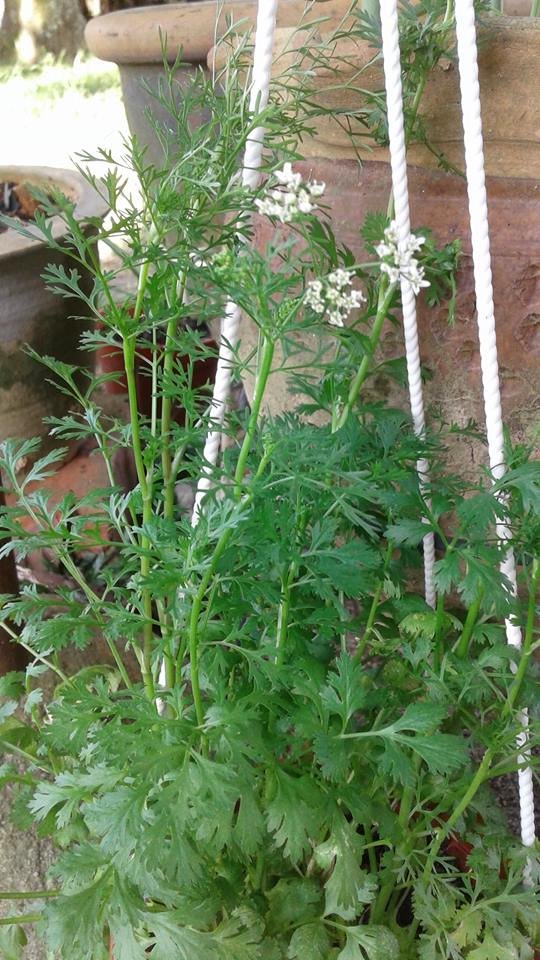Coriander (Coriandrum sativum) is a medicinal plant in the form of terna / herba, height 20-100 cm, stems when the bruise smells fragrant. Leaves sharing pinnate, do not have hair, berseludang with white edge. Compound interest in the form of an umbrella, flower stalk 2-10 cm, small leaf pads. Crown flowers are pink or pale red, 3-4 mm long flowers, some flowers that have bloomed fall. Fruits 4-5 mm long. Ecology. It grows in Java, Sumatra, as well as in mountainous areas with a height of 700-2. 000 m asl. Usually planted in the fields and in the yard of the house.
Plants can grow on a variety of soil types, but the most fitting of the soil is easy, clay soils that have lime or base-shaped content and well drained. The soil that has a lot of water content or acid-shaped is not good for cilantro. Soil that has too much nitrogen content leads to vegetative development, to reduce yields. Rainfall 1. 000 - 2. 000 mm / th .. Throughout the development of flowers and fruits until the harvest is cultivated a little rain. Planting in the moor is done in the mid to late rainy season. On irrigated soil, when planting is good in the dry season. In the tropics coriander is planted in mountainous areas. In the lowlands eventually less satisfactory.

Step Cultivation.
Plant propagation is done by seed. seeds taken from healthy seeds and cook. Processing of the soil is done by hoeing 2 times as deep as 25-30 cm, weeds cleaned, soil dissolved and flattened. Around the land that will be planted in drainage channels. The seeds are spread on a 2, 5 cm deep groove with a spacing of 10-15 days. Distance between grooves 35-100 cm. The seeds will grow after 10-15 days. After a considerable period, the plants were cultivated and weeded many times. Plants begin to bloom, when the formation of fruit, and harvest, wanting sunny weather so that the fruit does not quickly rot. In the dry season the land situation is kept moist by irrigating crops.



Step Harvest.
Plants are harvested when yellow brown, ie at age 3-3, 5 bln. from the time of planting. Harvest is done by cutting or removing plants and plants in the bundle and dried for 1 week or more. Seeds are released from the fruit and dried again to dry.


Benefits
Lower the sugar content in Diabetes patients. Inside coriander there is a substance in question cumin, where stimulation of cumin substances will increase insulin secretion from within the pancreas. this system will convert sugar into glycogen that will be used by the body, this kind of thing will give a positive impact on the decrease in blood sugar content to return to normal;
Handles a variety of skin problems. Coriander can cure various skin problems that arise such as eczema, dry skin and skin infections caused by fungi;
Protect the cycle as well as menstrual abnormalities. Coriander can stimulate the secretion of the hormone estrogen from the endocrine gland to be able to protect the discipline (cycle) menstruation and other abnormalities that may arise at the time of menstruation such as: excessive pain and others;
Protect eye health. The content of vitamins A, C, Minerals and phosphorus contained in the essential oil of coriander can help increase eye health, avoid macular degeneration, eyestrain, and coriander have anti-infection in conjunctivitis situation; handle diarrhea.
The basic borneol and linalool components present in the essential oil of cilantro help digestive health and help the bowel binding system in the gut can reduce and stop diarrhea; Anti Inflammatory (anti-inflammatory). The content of cineole and linoleic acid has anti-inflammatory, anti-rheumatic and reduces swelling of joints caused by rheumatic arthritis; Lower Cholesterol. Various acid compounds present in coriander such as linoleic acid, palmitic acid, ascorbic acid, oleic acid, stearic acid are believed to have a function and a major role in lowering blood cholesterol content.
